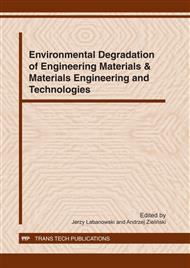p.43
p.49
p.57
p.65
p.71
p.81
p.89
p.95
p.101
The Effect of Low-Temperature Glow Discharge Nitriding of Duplex Stainless Steel on Absorption and Desorption of Hydrogen
Abstract:
The effect of the nitrided layers produced on ferritic-austenitic stainless steel to hydrogen absorption and desorption was studied. The layers were formed during low-temperature glow discharge nitriding process. The microstructure of steel after nitriding and cathodic hydrogen charging was investigated by means of X-ray diffraction and by scanning electron microscopy (SEM). One of the objectives was to determine the quantity of hydrogen absorbed by the steel samples with and without the nitrided layer. To determine the quantity of the diffusible and trapped hydrogen, the electrochemical permeation and desorption methods were used. The influence of the nitrided layer on the entry, absorption and desorption of hydrogen was determined. The results revealed that the nitrided layer hinders absorption of hydrogen into and desorption of hydrogen from the membrane.
Info:
Periodical:
Pages:
71-80
Citation:
Online since:
December 2011
Price:
Сopyright:
© 2012 Trans Tech Publications Ltd. All Rights Reserved
Share:
Citation:


